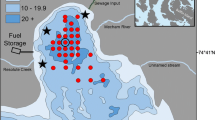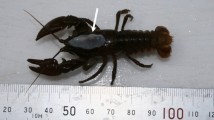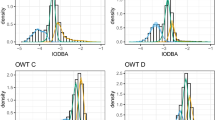Abstract
Fish behaviour can vary considerably in response to environmental and biological conditions. We used electronic Data Storage Tags (DSTs) to investigate the behaviour of cod in different environments; 74 North Sea cod and 20 Irish Sea cod were tagged and released in late-March 1999. So far, 32 tags (>2000 days of data) have been returned from the North Sea and four (>700 days) from the Irish Sea. The maximum recorded depth of a North Sea cod was 84 m, while Irish Sea cod utilised a depth range of 154 m. Active depth changes were of greater magnitude and rate in Irish Sea cod than North Sea cod. In addition, Irish Sea cod were continually active and made proportionally more active depth changes than North Sea cod, which were very active during migration (March–June) but exhibited little vertical movement during the summer months. To our knowledge, this is the first time that the behaviour patterns of cod from different stocks have been measured simultaneously over extended periods at such a fine temporal scale. In addition to describing considerable inter-stock differences in behaviour, our results suggest that while cod in the Irish Sea remain active and highly mobile throughout the year, North Sea cod reduce their movements during the summer feeding period. Our findings will contribute to the development of more biologically realistic management models used for evaluating the efficacy of fisheries technical measures, such as closed areas.
Similar content being viewed by others
References
Anon, 2000. Commission Regulation EC No. 2848/2000. Official Journal. L 35: 10-11.
Anon, 2001. Commission Regulation EC No. 259/2001. Official Journal L39: 7-10.
Arnold, G. P. & M. Greer-Walker, 1992. Vertical movements of cod (Gadus morhua L.) in the open sea and the hydrostatic function of the swimbladder. ICES J. Mar. Sci. 49: 357-372.
Arnold, G. P., M. Greer-Walker, L. Emerson & B. Holford, 1994. Movements of cod (Gadus morhua L.) in relation to the tidal streams in the southern North Sea. ICES J. Mar. Sci. 51: 207-232.
Arnold, G. P., J. Metcalfe, B. Holford & A. Buckley, 1997. Availability and accessibility of demersal fish to survey gears: New observations of ‘natural’ behaviour obtained with electronic data storage tags. ICES CM 1997/W:11.
Bailey, R., 1975. Observations on diel behaviour patterns of North Sea gadoids in the pelagic phase. J. mar. biol. Ass. U.K. 55: 133-142.
Clark, D. S. & J. Green, 1990. Activity and movement patterns of juvenile Atlantic cod, Gadus morhua, in Conception Bay, Newfoundland, as determined by sonic telemetry. Can. J. Zool. 68: 1434-1442.
Clark, D. S. & J. Green, 1991. Seasonal variation in temperature preference of juvenile Atlantic cod (Gadus morhua), with evidence supporting an energetic basis for their diel vertical migration. Can. J. Zool. 69: 1302-1307.
Fernö, A. & S. Olsen, 1994. Marine Fish Behaviour in Capture and Abundance Estimation. Blackwell Science Ltd., Oxford: 221 pp.
Giske, J., G. Huse, & O. Fiksen, 1998. Modelling spatial dynamics of fish. Rev. Fish Biol. Fish 8: 57-91.
Godin, J.-G., 1997. Behavioural Ecology of Teleost Fishes. Oxford University Press, Oxford: 384 pp.
Godø, O. R. & K. Michalsen, 2000. Migratory behaviour of northeast Arctic cod, studied by use of data storage tags. Fish. Res. 48: 127-140.
Green, J. & J. Wroblewski, 2000. Movement patterns of Atlantic cod in Gilbert Bay, Labrador: evidence for bay residency and spawning site fidelity. J. mar. biol. Ass. U.K. 80: 1077-1085.
Hart, P., 1993. Teleost foraging: facts and theories. In Pitcher, T. (ed.), The Behaviour of Teleost Fishes. Chapman and Hall, London: 253-284.
Hughes, N. & T. Grand, 2000. Physiological ecology meets the ideal-free distribution: predicting the distribution of sizestructured fish populations across temperature gradients. Envir. Biol. Fishes 59: 285-298.
Huse, G. & J. Giske, 1998. Ecology in Mare Pentium: an individualbased spatio-temporal model for fish with adapted behaviour. Fish. Res. 37: 163-178.
Hutchings, J., T. Bishop & C. McGregor-Shaw, 1999. Spawning behaviour of Atlantic cod, Gadus morhua: evidence of mate competition and mate choice in a broadcast spawner. Can. J. Fish. aquat. Sci. 56: 97-104.
Lawson, G. & G. Rose, 2000. Seasonal distribution and movements of coastal cod (Gadus morhua L.) in Placentia Bay, Newfoundland. Fish. Res. 49: 61-75.
Løkkeborg, S., 1998. Feeding behaviour of cod, Gadus morhua: activity rhythm and chemically mediated food search. Anim. Behav. 56: 371-378.
Løkkeborg, S. & A. Fernö, 1999. Diel activity pattern and food search behaviour in cod, Gadus morhua. Envir. Biol. Fishes 54: 345-353.
Mattson, S., 1990. Food and feeding habits of fish species over a soft sublittoral bottom in the north-east Atlantic. 1. Cod (Gadus morhua). Sarsia 75: 247-260.
Metcalfe, J. D. & G. P. Arnold, 1997. Tracking fish with electronic tags. Nature 387: 665-666.
Olla, B. L., M. Davis, C. Ryer & S. Sogard, 1996. Behavioural determinants of distribution and survival in early stages of walleye pollack, Theragra chalgogramma: a synthesis of experimental studies. Fish. Ocean. 5 (Suppl. 1): 167-178.
Pitcher, T. & P. Hart, 1982. Fisheries Ecology. Chapman and Hall, London: 414 pp.
Reynolds, J. & S. Jennings, 2000. The role of animal behaviour in marine conservation. In Gosling, L. & W. Sutherland (ed), Behaviour and Conservation. Cambridge University Press, Cambridge: 238-257.
Righton, D., J. Metcalfe & P. Connolly, 2001. Different behaviour of North and Irish Sea cod. Nature 482: 156.
Righton, D., K. Turner & J. Metcalfe, 2000. Behavioural switching in North Sea cod: implications for foraging strategy? ICES CM 2000/Q:09.
Rose, G. & W. Leggett, 1988. Atmosphere-ocean coupling and Atlantic cod migrations: effects of wind-forced variations in sea temperatures and currents on nearshore distributions and catch rates of Gadus morhua. Can. J. Fish. aquat. Sci. 45: 1234-1243.
Rose, G. A., 1993. Cod spawning on a migration highway in the north-west Atlantic. Nature 366: 458-461.
Sogard, S. M. & B. L. Olla, 1996. Diel patterns of behaviour in juvenile wall-eye pollack, Theragra chalcogramma. Envir. Biol. Fishes 47: 379-386.
Stensholt, B., K. Michalsen. & O. Godø, 2000. Behavioural rhythm of cod during migration in the Barents Sea. ICES CM 2000/K: 34.
Stephens, D. W. & J. Krebs, 1986. Foraging Theory. Princeton University Press, Princeton, New Jersey: 247 pp.
Sumpter, D. J. & D. Broomhead, 2001. Relating individual behaviour to population dynamics. Proc. R. Soc. Lond. B. 268: 925-932.
Sutherland, B., 1996. From Individual Behaviour to Population Ecology. Oxford University Press, Oxford: 213 pp.
Travis, J. & C. Dytham, 1998. The evolution of dispersal in a metapopulation: a spatially explicit individual-based model. Proc. R. Soc. Lond. B. 265: 17-23.
Turner, K., D. Righton & J. D., Metcalfe, 2002. The dispersal patterns and behaviour of North Sea cod (Gadus morhua) studied using electronic data storage tags. Hydrobiologia 483/Dev. Hydrobiol. 165: 201-208.
Vilhjalmur, T. & I. Gudjon, 1998. Vertical migration patterns of Atlantic cod (Gadus morhua) in Icelandic waters, results from electronic data storage tags (DSTs). ICES CM 1998/B:13.
Wroblewski, J., B. Nolan, G. Rose & B. deYoung, 2000. Response of shoaling Atlantic cod to ocean currents on the northeast Newfoundland shelf. Fish. Res. 45: 51-59.
Wroblewski, J. S., R. Smedbol, C. Taggart & S. Goddard, 1996. Movements of farmed and wild Atlantic cod (Gadus morhua) released in Trinity Bay, Newfoundland. Mar. Biol. 124: 619-627.
Zilanov, V. K., 1963. The cod (Gadus morhua morhua Linné) over great depths of the open sea. Zoologicheskii Zhurnal 42: 1108-1109 (in Russian: translation held at Fisheries Laboratory, Lowestoft).
Rights and permissions
About this article
Cite this article
Righton, D., Metcalfe, J. Multi-torsking: simultaneous measurements of cod behaviour show differences between North Sea and Irish Sea stocks* . Hydrobiologia 483, 193–200 (2002). https://doi.org/10.1023/A:1021387831445
Issue Date:
DOI: https://doi.org/10.1023/A:1021387831445




